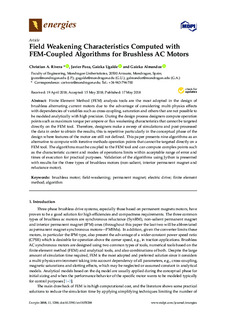| dc.rights.license | Attribution 4.0 International | * |
| dc.contributor.author | Rivera, Christian A. | |
| dc.contributor.author | Almandoz, Gaizka | |
| dc.contributor.author | Ugalde, Gaizka | |
| dc.contributor.author | Poza, Javier | |
| dc.date.accessioned | 2018-07-27T14:26:43Z | |
| dc.date.available | 2018-07-27T14:26:43Z | |
| dc.date.issued | 2018 | |
| dc.identifier.issn | 1996-1073 | eu_ES |
| dc.identifier.other | https://katalogoa.mondragon.edu/janium-bin/janium_login_opac.pl?find&ficha_no=147798 | eu_ES |
| dc.identifier.uri | https://hdl.handle.net/20.500.11984/1100 | |
| dc.description.abstract | Finite Element Method (FEM) analysis tools are the most adopted in the design of
brushless alternating current motors due to the advantage of considering multi-physics effects
with dependencies of variables such as cross-coupling, saturation and others that are not possible to
be modeled analytically with high precision. During the design process designers compute operation
points such as maximum torque per ampere or flux weakening characteristics that cannot be targeted
directly on the FEM tool. Therefore, designers make a sweep of simulations and post-processed
the data in order to obtain the results, this is repetitive particularly in the conceptual phase of the
design where features of the motor are still not defined. This paper presents nine algorithms as an
alternative to compute with iterative methods operation points that cannot be targeted directly on a
FEM tool. The algorithms must be coupled to the FEM tool and can compute complex points such
as the characteristic current and modes of operations limits within acceptable range of error and
times of execution for practical purposes. Validation of the algorithms using Jython is presented
with results for the three types of brushless motors (non-salient, interior permanent magnet and
reluctance motor). | |
| dc.description.sponsorship | This work has been partially supported by the program: “Red guipuzcoana de Ciencia, Tecnología e Innovación 2017” from Diputación Foral de Guipuzkoa. | eu_ES |
| dc.language.iso | spa | eu_ES |
| dc.publisher | MDPI AG | eu_ES |
| dc.rights | © 2018 by the authors | eu_ES |
| dc.rights.uri | http://creativecommons.org/licenses/by/4.0/ | * |
| dc.subject | AC grids | eu_ES |
| dc.subject | analytical modeling | eu_ES |
| dc.subject | design approach | eu_ES |
| dc.subject | harmonic mitigation | eu_ES |
| dc.subject | active impedance | eu_ES |
| dc.subject | power system stability | eu_ES |
| dc.title | Field Weakening Characteristics Computed with FEM-Coupled Algorithms for Brushless AC Motors | eu_ES |
| dcterms.accessRights | http://purl.org/coar/access_right/c_abf2 | eu_ES |
| dcterms.source | Energies | eu_ES |
| local.contributor.group | Accionamientos aplicados a la tracción y a la generación de energía eléctrica | eu_ES |
| local.description.peerreviewed | true | eu_ES |
| local.identifier.doi | https://doi.org/10.3390/en11051288 | eu_ES |
| local.relation.projectID | Diputación Foral de Gipuzkoa. Aplicación de la metodología MOKA para la captura de conocimiento en Diseño y Fabricación de Máquinas Eléctricas MOKAMAQ. | eu_ES |
| local.source.details | Vol. 11. Nº 5 | eu_ES |
| oaire.format.mimetype | application/pdf | |
| oaire.file | $DSPACE\assetstore | |
| oaire.resourceType | http://purl.org/coar/resource_type/c_6501 | eu_ES |
| oaire.version | http://purl.org/coar/version/c_970fb48d4fbd8a85 | eu_ES |








